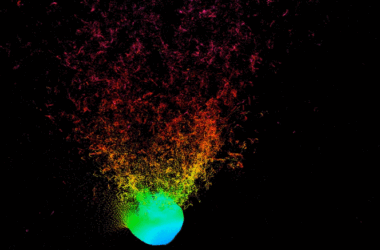
Cette illustration est une impression d’artiste du mince disque de débris rocheux découvert autour des deux naines blanches Hyades. On pense que les astéroïdes rocheux ont été perturbés par des planètes au sein du système et détournés vers l’étoile, où ils se sont brisés, ont formé un anneau de débris, puis ont été entraînés sur l’étoile elle-même. Crédit : NASA, ESA, STScI, et G. Bacon (STScI)
Les naines blanches étaient autrefois des étoiles normales semblables au Soleil, mais elles se sont effondrées après avoir épuisé tout leur carburant. Historiquement, ces vestiges interstellaires ont été difficiles à étudier. Une étude récente menée par des astronomes de l’Université de Lund, en Suède, révèle toutefois de nouvelles informations sur les mouvements de ces étoiles qui laissent perplexe.
Les naines blanches ont un rayon d’environ 1 % de celui du Soleil. Elles ont à peu près la même masse, ce qui signifie qu’elles ont une densité étonnante d’environ 1 000 kg (2 200 livres) par centimètre cube. Après des milliards d’années, les naines blanches se refroidissent jusqu’au point où elles n’émettent plus de lumière visible et se transforment en naines noires.
40 Eridani A a été la première white dwarf discovered. It is a bright celestial body 16.2 light-years away from Earth, surrounded by a binary system consisting of the white dwarf 40 Eridani B and the red dwarf 40 Eridani C. Ever since it was discovered in 1783, astronomers have tried to learn more about white dwarfs in order to gain a deeper understanding of the evolutionary history of our home galaxy.
In a study published in the journal Monthly Notices of the Royal Astronomical Society, a research team can present new findings of how the collapsed stars move.

Illustration of Gaia with the Milky Way in the background. Gaia is an ambitious mission to chart a three-dimensional map of our Galaxy, the Milky Way, in the process revealing the composition, formation and evolution of the Galaxy. Credit: ESA–D. Ducros, 2013
“Thanks to observations from the Gaia space telescope, we have for the first time managed to reveal the three-dimensional velocity distribution for the largest catalog of white dwarfs to date. This gives us a detailed picture of their velocity structure with unparalleled detail,” says Daniel Mikkola, doctoral student in astronomy at Lund University.
Thanks to Gaia, researchers have measured positions and velocities for about 1.5 billion stars. But only recently have they been able to completely focus on the white dwarfs in the Solar neighborhood.
“We have managed to map the white dwarfs’ velocities and movement patterns. Gaia revealed that there are two parallel sequences of white dwarfs when looking at their temperature and brightness. If we study these separately, we can see that they move in different ways, probably as a consequence of them having different masses and lifetimes,” says Daniel Mikkola.
The results can be used to develop new simulations and models to continue to map the history and development of the Milky Way. Through an increased knowledge of the white dwarfs, the researchers hope to be able to straighten out a number of question marks surrounding the birth of the Milky Way.
“This study is important because we learned more about the closest regions in our galaxy. The results are also interesting because our own star, the Sun, will one day turn into a white dwarf just like 97 percent of all stars in the Milky Way,” concludes Daniel Mikkola.
Reference: “The velocity distribution of white dwarfs in Gaia EDR3″ by Daniel Mikkola, Paul J McMillan, David Hobbs and John Wimarsson, 22 February 2022, Monthly Notices of the Royal Astronomical Society.
DOI: 10.1093/mnras/stac434



